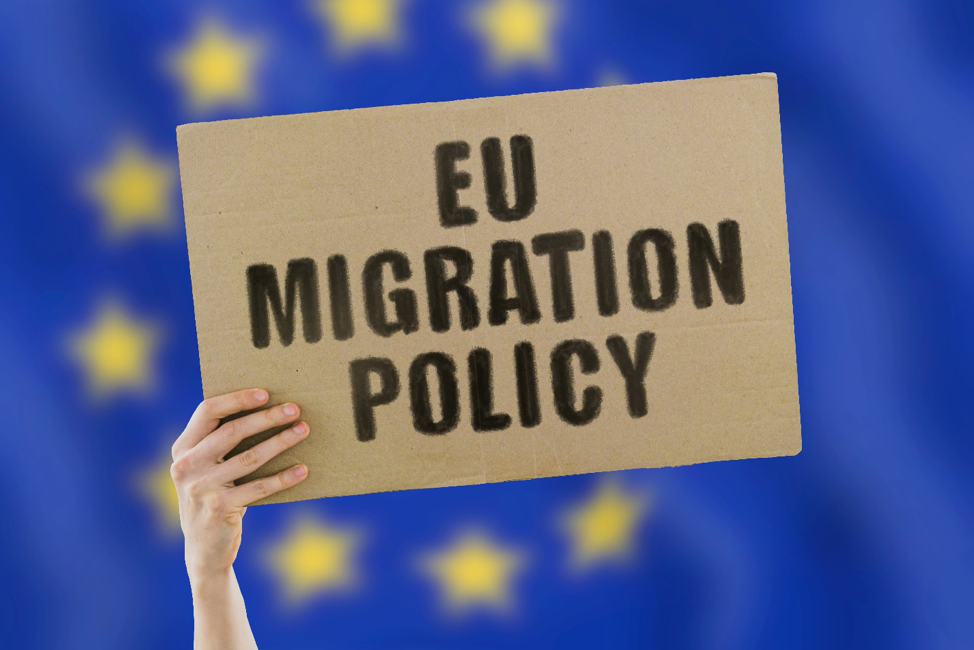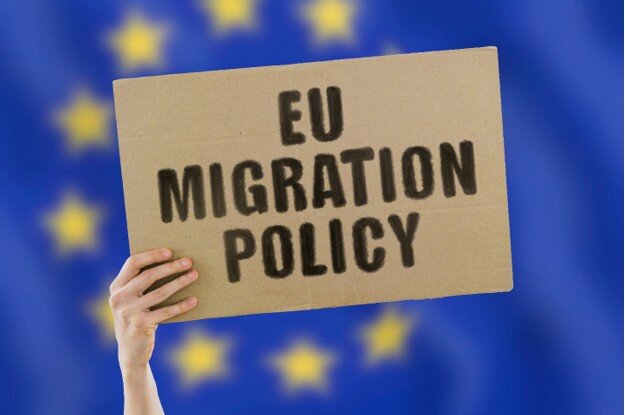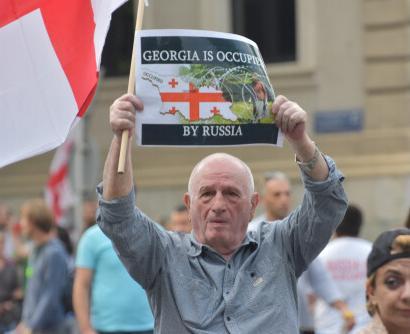Abstract: The paper analyses the foreign aid directed towards migration-governance and presents an analysis of the democratic institution-building overall, as well as in terms of migration governance, which has been developed in third-countries through EU Foreign Aid. Ultimately, the following questions are addressed: To what extent does the method of ‘institution-building’ in third countries affect migration towards the EU? Has the EU been successful in strengthening democratic institutions through financial aid to migrants’ countries of origin’? Can EU foreign-aid help strengthen migration governance overseas? Should the EU focus on other more effective, faster methods to establish better migration governance?
Bottom-line-up-front: When it comes to migration, we must distinguish between refugee flows and economic migration. In cases of refugee flows, migrants are forcedly displaced due to political instability, persecution, military conflict or natural disasters. The second aspect refers to economic migration, which can be reduced by using foreign aid as an instrument. Although researchers have successfully proven the positive effects of foreign aid on economic development, the link to migration-governance is missing.
Problem statement: How to assess the EU’s foreign aid policy’s effectiveness and efficiency in the light of illicit migration to Europe?
So what?: EU aid must be channelled towards improving assistance towards local institutions, governance and policy-making in third-countries. Development aid must be the preferred form of aid to improve local conditions to reduce outflows of irregular migrants towards the EU. Institution-Building in urban areas is the most effective form of reducing emigration, considering the high emigration rates from these areas. Along with controlling migration, institution-building has also proven to strengthen democratic values and processes, inducing peace and creating room for conflict control and reduction.

Source: shutterstock.com/AndriiKoval
The EU and Migration
Since migration has been a high-politics issue within the EU’s integration policy, the EU and its institutions, as well as individual states, have engaged in several methods to reduce the influx of refugees and illegal migrants. After the 2015 ‘Migration Crisis’, the urgent need to regulate and control irregular migration flows was highlighted. To address the various massive migration flows, the EU also applies a ‘root-cause’ approach to migration, besides also engaging in strengthening its borders against illegal trafficking, increased monitoring, and regulation through institutions like FRONTEX. The said ‘root-cause’ approach has led the EU to regulate migration to the EU from origin countries of migration.[1] As the EU regularly disburses aid to developing neighbouring countries in Africa as well as Asia, which are hotspots of migration-origins, the EU aims to address the problem of by directly improving the living conditions for people in these countries.
To address the various massive migration flows, the EU also applies a ‘root-cause’ approach to migration, besides also engaging in strengthening its borders against illegal trafficking, increased monitoring, and regulation through institutions like FRONTEX.
‘Institution-Building’ comes across as one of the main factors directly affecting overall governance and migration governance in third countries. As institution-building is directly carried out through development aid disbursed by the EU, it is also involved in spreading democratic and internationally-recognised practices in third-countries.[2] As several third-countries are plagued by issues, including corruption, unstable democracies, etc., this development’s exact extent is uncertain and uneven.
Moreover, there is only limited availability of relevant data to ascertain the assumptions. Complex systems of the disbursal of foreign aid also affect the real-world effectiveness of foreign aid from the EU.[3] Academic evidence so far only points to links between factors like aid and economic development. Although economic development is a variable whilst considering migration, only limited academic work focuses on the link between foreign aid and migration inflows. Moreover, the link between foreign aid and democratic institution-building has not been adequately researched.
Foreign Aid and Migration Governance
To reduce the incessant flows of irregular migrants to the EU, advocates of foreign aid have been pushing to maximise foreign aid disbursal to migrant-origin countries.[4] The EU has also tried to include this approach to regularise and reduce the inflow of migrants, intending to increase its security and protection from steady inflows of migrants and their induced effects domestically. Arrayo, in his book, ‘Using EU Aid to Address the Root Causes of Migration and Refugee Flows’ (2019), also confirms that EU institutions have indeed included developmental aid as an instrument to reduce migration flows to the EU. In 1994, the ministers of development cooperation asked the European Commission to explore developmental assistance to reduce migration flows.[5] In 2007, the French Foreign Minister, Bernard Kouchner, on his first official trip to Africa, urged for more development aid to the region to help curb migration.[6] In 2018, the then President of the European Parliament suggested that the EU should adopt a sort of Marshall Plan for Africa to reduce future migration from this continent.[7]
The European Commission highlighted the use of developmental assistance through its recent endeavours on migration, namely the ‘Global Approach to Migration’ in 2005[8], the ‘European Agenda on Migration’ in 2015, and the 2016 Communication establishing a Partnership Framework with third-countries on Migration.[9] The 2020 ‘New Pact on Migration and Asylum’ continues to proceed in a similar direction. The impact of aid on migration must, however, be distinguished between refugee flows and economic migration.[10] This is due to the motives behind migration itself. In cases of refugee flows, migrants are forcibly displaced due to political instability or persecution or military conflict. These issues can usually be solved by the EU more politically, rather than economically. The second aspect refers to economic migration, which can be tackled by using foreign aid as an instrument. Although researchers have successfully proven the positive effects of foreign aid on economic development, the link to migration-governance is missing. These studies also reflect that in several cases, the effect of economic development through foreign aid on migration is the opposite. Moreover, economic development may increase the flows of outward migration from certain developing countries[11], where rapidly declining mortality rates and stable fertility rates induce a so-called ‘baby-boom’, motivating numerous unemployed youths to look to emigrating to the EU. Other research indicates that the ‘network or attraction effect’ through existing friends, family and contacts is a key ingredient in increasing migration flows.[12] Due to the available ‘ease’ of migration through bilateral partnerships of EU countries with third-countries (in humanitarian, post-colonial or labour-migration pacts), the ‘diaspora’ or ‘friends and family’ effect causes an increase in migration even in cases of economic growth in certain countries. Due to such anomalies, the EU must be cautious with its foreign aid disbursal. Sufficient research and studies of demographics and conditions in particular countries may only indicate the possible effects of aid disbursal in third-countries.
Although researchers have successfully proven the positive effects of foreign aid on economic development, the link to migration-governance is missing. These studies also reflect that in several cases, the effect of economic development through foreign aid on migration is the opposite.
Another key aspect while analysing foreign aid towards migration governance concerns the importance of the donors’ self-interests or strategies whilst ignoring the recipient country’s needs. Trade relations, political similarities or colonial ties are expressed as ‘important determinants’ of bilateral aid allocations.[13] Therefore, foreign aid allocation may be significantly determined through bilateral ties and other existing pacts. These factors may have diverse impacts on migration governance. However, the ambiguity surrounding foreign aid to migration governance remains prominent through these aid allocations. Czaika and Mayerhighlighted that while humanitarian assistance was clearly reactive to displacement flows, the response of long-term development assistance was much weaker, especially in the case of internal displacements and displacements of refugees towards countries of the first claim of asylum.[14] This confirms the ‘self-interest’ determinant of the donors’, portraying that the EU is more responsive to situations in which it is directly affected through an inflow of forcibly displaced persons, rather than situations of internal displacements (IDPs), which adversely affect the ‘root-causes’ to migration towards the EU. According to Gamso and Yuldashev (2018), aid towards rural development is likely to cause migration which is more likely to be domestic, and not directed towards the EU.
On the other hand, foreign aid towards urban development is more likely to cause emigration towards Europe and elsewhere. This is also due to migration networks, the ease of communication and travel and the cheaper prices of emigration from urban areas.[15]
‘Aid effectiveness’ is a key factor while measuring the positive and negative implications of aid allocations.[16] According to their studies, aid effectiveness can be maximised through efficient coordination between donor countries. As the EU continues to improve involving this strategy in its’ aid-allocation relationships with third-countries, the implications of foreign aid on migration governance may be further analysed through the effectiveness of foreign-aid on democratic institution-building in third-countries, which may prove to become deterrents of irregular emigration in the future. Consequently, the relationship between foreign aid and migration is extremely complex and partly subjective according to local conditions.
Democratic Institution-Building through Foreign Aid and its’ Implications on Migration Governance
A key aspect to understand institution-building through EU foreign aid is the EU ODA (Official Development Assistance). The EU is the largest dispenser of aid globally, with approximately EUR75.2 Billion disbursed in 2019. This contribution amounts to 55% of global aid assistance.[17] In recent years, EU ODA has also been more successful in targeting aid towards countries experiencing forced displacement and emigration.[18] Democratic Institution-Building and improving governance through these aid allocations is an essential part of the EU ODA. Improving governance (“political development assistance”) reduces migration by promoting better institutions, less corruption and more political stability. Therefore, migration may be heavily influenced by the local populations’ confidence in their institutions and governance structures. Hence, these aspects of democracies clearly contribute to the measurement of an individual’s quality of life and satisfaction with local amenities, which play a large role in migration motivations and intentions.
Democratic Institution-Building is also an integral part of the ‘security-community’ approach applied by the EU towards its neighbours to the south and the east, mainly through the European Neighbourhood Policy (ENP).[19] The ‘security-community’ approach ensures long-lasting peace, wherein states within it display dependence on each other for mutual benefit, cooperation and peace. Such practices of institution-building are carried out through multilateral cooperation, enabling the creation of regional spaces where enhanced networks between countries’ governments allow the strengthening and regularisation of international practices and standards. In countries where governance is weak, such forums and assistance enable the strengthening of institutions, which automatically strengthens overall democracy in these countries, effectively creating confidence and faith in local governance systems. Barring bilateral relationships between member states and third-countries, EU institutions provide democratisation through a broader approach. In multilateral settings, polarisation and contention over specific national issues may be avoided, enabling further cooperation and strengthening of relations. These factors, along with the involvement of the EU as a whole instead of specific member states alone, have contributed to the betterment of migration governance and other policy areas and trade and security cooperation on multiple issues. As the case study by Bremberg (2015) on Morocco shows, increased practical cooperation between Morocco and the EU, including Spain, is key to develop democratisation in third-countries such as Morocco, which are essential neighbours in discussions involving migration governance.[20] In 2008, Morocco was granted the ‘advanced status’, reiterating the EU’s focus on such key neighbouring countries.
The ‘security-community’ approach ensures long-lasting peace, wherein states within it display dependence on each other for mutual benefit, cooperation and peace.
Hence, the promotion of democratic values is intensified by the EU’s involvement in foreign aid allocation through avenues like the ENP. In 2011, the ENP’s commitment to transformative change in the neighbourhood was upgraded to emphasise promoting not just democracy but ‘deep democracy’.[21] Deep democracy seems to combine concern with institutions and elections with a more wholesale ‘reform of societies’ economic, civic, cultural and political structures’.[22] Macro-financial assistance through the IMF, the EU and other bilateral and multilateral commitments to third-countries is, therefore, vital to reducing migration outflows.
Institution-Building may also be considered an integral part of the ‘capacity-building’ or ‘capacity-development’ approach used by the EU to further develop in third-countries. According to the European Parliament’s briefing in 2017, ‘capacity-development’ is the new term coined to better express an approach that builds on existing skills and knowledge, driving a dynamic and flexible process of change borne by local actors.[23] This term goes beyond the traditional interpretation of ‘capacity-building’, in reference to the need to improve state and local governments’ capacity to implement fiscal decentralisation policies. Capacity-building does not recognise existing capacity and operates with a pre- imposed design, while capacity development suggests an endogenous process of change.[24] The European Commission’s ‘Toolkit for Capacity Building’ (2010) is the EU’s guiding framework to implement these strategies. Capacity development must be ‘owned by those who develop capacity’. The EU recognises these caveats and can only support these strategies but not own or implement them. According to the 2009 ‘Council conclusions on democracy support’, the EU external support for democracy, which is implemented in synergy with EU development policy, aims to strengthen the capacity of governments, parliaments and other state institutions, political actors, civil-society organisations and other actors. In the area of security, according to the April 2015 ‘Joint Communication on Capacity building in support of security and development – Enabling partners to prevent and manage crises’, capacity-building efforts in this area aim to build ‘effective, legitimate and sustainable institutions, including effective justice and security sectors, border control and coast guards’. The activities deployed to achieve these objectives include political dialogue, technical cooperation, training and the provision of essential equipment and material.[25] The European Parliament further intensifies these efforts of institution-building through cooperation with third-country parliaments. As part of its support for democracy and elections, the EP assists parliaments in third countries to strengthen their institutional capacity. More specifically, EP programmes focus on strengthening the parliamentary functions, setting up parliamentary organisations, implementing administrative and institutional reform, and sharing best practices. The EP has set up a special political group, the Democracy Support and Election Coordination Group (DEG) to achieve these objectives.
According to the 2009 ‘Council conclusions on democracy support’, the EU external support for democracy, which is implemented in synergy with EU development policy, aims to strengthen the capacity of governments, parliaments and other state institutions, political actors, civil-society organisations and other actors.
EU Aid towards migration is also channelled through organisations like the IOM (International Organisation for Migration) and the UNHCR (United Nations High Commissioner for Refugees).[26] According to Lavenex, these organisations have become linked to the development, implementation and diffusion of EU external migration policies. They function as counterweights, where they correct and complement EU Policies, as subcontractors to execute and implement migration projects, and as transmitters or ‘transfer agents’.[27] The EU uses a project-based funding approach to implement these changes. As strengthening migration governance is one of these projects’ main objectives, EU Aid ultimately also supports institution-building through these intermediaries. An example of such institution-building projects on migration is the “Capacity Building of Institutions Involved in Migration Management and Reintegration of Returnees in the Republic of Serbia”, carried out by the IOM through co-funding from the EU. The project included a series of training, workshops, study trips, research, data-sharing, etc., for Serbian locals involved in the government.[28]
Therefore, the impact of EU foreign aid on institution-building in migration is vast and complex. It is channelled through various forms and institutions.
The EU uses a project-based funding approach to implement these changes. As strengthening migration governance is one of these projects’ main objectives, EU Aid ultimately also supports institution-building through these intermediaries.
Conclusion
The above findings mainly depict the very complex relationship between migration governance and foreign aid. As the EU uses multiple avenues to disburse aid and institutional support, measuring the impacts of these forms of assistance is currently tough to gauge. Various institutions of the EU itself and migration-related international organisations, civil-society organisations, and NGOs are involved in strengthening institutions to better migration governance in third-countries. Policy frameworks including the ENP, regional and bilateral compacts, are directly involved with short-term as well as long-term solutions to migration issues. Although the EU’s approach comes across as ‘panicky’ in certain situations where it is directly affected, its root-cause approach also seems practical to a certain extent. The main shortcomings of EU aid towards institution-building and democratic promotion include insufficient coordination between donors and allocation of aid which could promote irregular migration through the availability of income.
Therefore, EU aid must be channelled towards improving assistance towards local institutions, governance and policy-making in third-countries. Although humanitarian aid is necessary in multiple unstable situations, development aid must be the preferred form of aid to improve local conditions to reduce outflows of irregular migrants towards the EU. Institution-Building in urban areas would be the most effective form of reducing emigration, considering the high emigration rates from these areas. In rural areas, institution-building may not have a considerable effect, as emigration rates from these areas are already low. Along with controlling migration, institution-building has also proven to strengthen democratic values and processes, inducing peace and creating room for conflict control and reduction.
Foreign aid can be increasingly effective with increased donor coordination and targeting. When aid is used to improve basic public infrastructure and facilities, including local governance, education, health infrastructure, water and electricity, migration rates can be reduced effectively. Aid effectiveness can also be increased if framed in the context of bilateral cooperation compacts or partnerships that facilitate donor coordination and increase their leverage to persuade recipient countries to adopt the necessary regulatory and policy reforms, including, where appropriate, measures to facilitate the access of displaced people to their formal labour markets and public services.
Although humanitarian aid is necessary in multiple unstable situations, development aid must be the preferred form of aid to improve local conditions to reduce outflows of irregular migrants towards the EU. Institution-Building in urban areas would be the most effective form of reducing emigration, considering the high emigration rates from these areas. In rural areas, institution-building may not have a considerable effect, as emigration rates from these areas are already low.
In times of a pandemic, migration has been adversely impacted. Institution-building and the strengthening of democracies remain a viable solution to avoiding increased migration flows in a post-pandemic world. Recent conservative developments in states such as Hungary and Poland further project difficulties for migrants arriving and integrating in the EU. These developments exhibit the political misuse of the pandemic to increase polarisations within the EU.
Moreover, the pandemic’s health and economic effects in third-countries have displayed inefficiencies in public health and other infrastructure. This infrastructure, along with access to vaccines and health services, must be bolstered up through foreign aid to increase the ease of living in affected countries. In turn, the betterment of standards of living would decrease emigration rates.
Therefore, the EU must continue the strengthening of democracies in third-countries to tackle migration. Although there remains a considerable amount of work needed to be done to improve institutions and capacities in third-countries, progress has shown that institution-building through improvements in governance, public infrastructure, civil-society organisations and NGOs is a crucial victory for foreign aid allocation and assistance. Along with tackling current issues and conflicts, stronger institutions and cooperation assure increased security and control over irregular migration.
Shivraj Jagtap is a Master’s student of Global Studies at the University of Vienna, Austria. He has completed a Bachelor’s in German Studies at the Jawaharlal Nehru University, New Delhi, India, and holds a key interest in Global Governance, Public Policy, Environmental & Migration Policy. He also holds vital experiences of volunteering and working with multiple non-profit organisations in India and abroad. The views contained in this article are the author’s alone and do not represent the views of the University of Vienna.
[1] Ilke Adam , Florian Trauner , Leonie Jegen and Christof Roos, West African interests in (EU) migration policy. Balancing domestic priorities with external incentives, Journal of Ethnic and Migration Studies (2020), 46:15, 3101-3118, DOI: 10.1080/1369183X.2020.1750354.
[2] Richard Youngs, Democratic institution-building and conflict resolution: emerging EU approaches, International Peacekeeping (2004), 11:3, 526-543, DOI: 10.1080/1353331042000249082.
[3] Heliodoro Arrayo, “Using EU Aid to Address the Root Causes of Migration and Refugee Flows,” European University Institute (2019), doi:10.2870/463755.
[4] Idem.
[5] Hein De Haas, “Turning the Tide? Why Development Will Not Stop Migration,” Development and Change 38(5), (Oxford: Blackwell Publishing, 2007).
[6] Reuters, “Kouchner says aid can curb migration on Africa tour,” 2007, last accessed April 25, 2021, https://bit.ly/2DiUu7J.
[7] Antonio Tajani, “Keynote Speech by Antonio Tajani, President of the European Parliament, at The State of the Union 2018 Conference,” European University Institute, Florence, May 11, 2018.
[8] European Commission, COMMUNICATION FROM THE COMMISSION TO THE EUROPEAN PARLIAMENT, THE COUNCIL, THE EUROPEAN ECONOMIC AND SOCIAL COMMITTEE AND THE COMMITTEE OF THE REGIONS – Applying the Global Approach to Migration to the Eastern and South-Eastern Regions Neighbouring the European Union, 2007, last accessed April 25, 2021, https://eur-lex.europa.eu/legal-content/EN/TXT/PDF/?uri=CELEX:52007DC0247R(01)&from=EN.
[9] European Commission, COMMUNICATION FROM THE COMMISSION TO THE EUROPEAN PARLIAMENT, THE EUROPEAN COUNCIL, THE COUNCIL AND THE EUROPEAN INVESTMENT BANK on establishing a new Partnership Framework with third countries under the European Agenda on Migration, 2016, last accessed April 25, 2021, https://www.europarl.europa.eu/RegData/docs_autres_institutions/commission_europeenne/com/2016/0385/COM_COM(2016)0385_EN.pdf.
[10] Heliodoro Arrayo, “Using EU Aid to Address the Root Causes of Migration and Refugee Flows,” European University Institute (2019), doi:10.2870/463755.
[11] Mauro Lanati and Rainer Thiele, “The Impact of Foreign Aid on Migration Revisited,” EUI Working Papers, MWP 2017/05 (San Domenico di Fiesole: European University Institute, 2017).
[12] Jean-Claude Berthélemy, Monica Beuran and Mathilde Maurel, “Aid and Migration: Substitutes or Complements?,” World Development 37(10), 2009, 1589-1599.
[13] Alberto Alesina and David Dollar, “Who Gives Foreign Aid and to Whom and Why?,”Journal of Economic Growth 5(1), 2000, 33-63.
[14] Mathias Czaika and Amy Mayer, “Refugee Movements and Aid Responsiveness of Bilateral Donors,” The Journal of Development Studies 47(3), 2011, 455-474.
[15] Jonas Gamso and Farhod Yuldashev, “Does Rural Development Aid Reduce International Migration?,” World Development 110, 2018, 268-282.
[16] Mauro Lanati and Rainer Thiele, “The Impact of Foreign Aid on Migration Revisited,” EUI Working Papers, MWP 2017/05 (San Domenico di Fiesole: European University Institute, 2017).
[17] European Commission Press Release, “The European Union remains world’s leading donor of Official Development Assistance with €75.2 billion in 2019,” 2020, last accessed April 25, 2021, https://ec.europa.eu/commission/presscorner/detail/en/IP_20_674.
[18] Heliodoro Arrayo, “Using EU Aid to Address the Root Causes of Migration and Refugee Flows” European University Institute (2019), doi:10.2870/463755.
[19] Niklas Bremberg, The European Union as security community-building institution: Venues, networks and co-operative security practices, Journal of Common Market Studies (2015), 53(3), 674-692.
[20] Idem.
[21] European Commission and High Representative of the EU for Foreign Affairs and Security Policy, A New Response to a Changing Neighbourhood: A Review of European Neighbourhood Policy, COM (2011) 303, Brussels.
[22] Christopher Browning, “The Construction and Deconstruction of the EU’s Neighbourhood,” The Routledge Handbook on the European Neighbourhood Policy (2017), 119-129.
[23] European Parliament Briefing, Understanding capacity-building / capacity development – A core concept of development policy, 2017, last accessed April 25, 2021, https://www.europarl.europa.eu/RegData/etudes/BRIE/2017/599411/EPRS_BRI(2017)599411_EN.pdf.
[24] European Commission, JOINT COMMUNICATION TO THE EUROPEAN PARLIAMENT AND THE COUNCIL’ – Capacity building in support of security and development – Enabling partners to prevent and manage crises, 2015, last accessed April 25, 2021, https://eur-lex.europa.eu/legal-content/EN/TXT/PDF/?uri=CELEX:52015JC0017&from=en.
[25] Idem.
[26] Anne Koch, The Politics and Discourse of Migrant Return: The Role of UNHCR and IOM in the Governance of Return, Journal of Ethnic and Migration Studies (2014), 40:6, 905-923, DOI: 10.1080/1369183X.2013.855073.
[27] Diane Stone, “Transfer Agents and Global Networks in the “Transnationalization” of Policy,” Journal of European Public Policy 11 (3): 545–566.
[28] International Organization for Migration, ‘Final Evaluation Report’ – “Capacity Building of Institutions Involved in Migration Management and Reintegration of Returnees in the Republic of Serbia,” 2013, last accessed April 25, 2021, https://returnandreintegration.iom.int/system/files/resources/document/independent_evaluation_cbmm_serbia_final_evaluation_report_2013.pdf?type=node&id=151&lang=fr.






